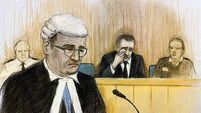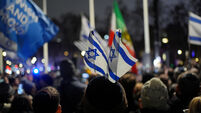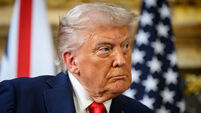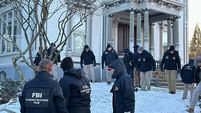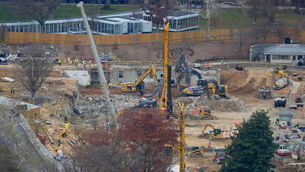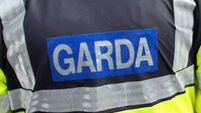Attacks widen as diplomats struggle over ceasefire plan
Israeli warplanes intensified airstrikes and launched a new commando raid in south Lebanon today, killing at least 28 people in one of the heaviest tolls in days.
Lebanon police said five people were killed when in the capital when three loud explosions rocked Beirut shortly after nightfall and within two hours of the departure of Arab foreign ministers who had gathered in the Lebanese capital in a show of support for the embattled government.
Lebanese security officials said Israel naval artillery fired on the southern suburbs from ships off the Mediterranean coast, where they also are enforcing a sea blockade.
Lebanon’s prime minister, choking back tears, pleaded for a ceasefire but demanded that any UN-drafted plan require a full Israeli withdrawal from his country.
Fuad Saniora’s emotional address to Arab League diplomats including a stunning claim that more than 40 people had just been killed by Israeli bombs in the border village of Houla. Later, he said just one person was killed and blamed the error on information from the battlefield, but offered no other explanation.
The diplomatic push for a cease-fire was revving up, but with many obstacles still in the way.
Saniora has proposed speeding the deployment of Lebanese troops in the south to help stop the fighting, but said Israeli troops must also pull out of Lebanese territory.
Saniora got strong backing from Arab nations, whose foreign ministers gathered in Beirut and called for changes in a US-French cease-fire plan to include Lebanon’s proposals. A high-level delegation, including Arab League Secretary-General Amr Moussa, headed to the United Nations to press for the revisions.
Meanwhile, Israeli and Hezbollah guerrillas appeared to press their offensives before any credible truce proposal takes shape.
Hezbollah sent at least 83 missiles into northern Israel, lightly wounding five Israelis, according to Israeli rescue services.
Yesterday, Hezbollah rockets killed 15 people in the single bloodiest day for Israelis.
Israeli Defence Minister Amir Peretz responded by ordering the army to step up the offensive against Hezbollah rocket sites.
Peretz told the top parliamentary committee on security affairs that in the absence of a diplomatic agreement, he has instructed the army to “take control” of launch sites and “take the Israeli people out of the shelters.”
The latest Israeli push included a head-on ground clashes aimed at flushing out Hezbollah militiamen from the border zone. The village of Houla is caught in the centre of the clashes. Getting an accurate count on casualties from the area was severely complicated by the ongoing fighting.
But at least 23 other Lebanese were confirmed dead by rescue and security officials in bombardment elsewhere – the highest one-day Lebanese death toll in days. An Israeli soldier died today in ground fighting near the southern port of Tyre, the military said.
Rescue officials had initially reported seeing five bodies following an air strike near Tyre. But they later said the deaths were not confirmed and were based on witness reports of people trapped in the rubble.
Hopes for a peace plan rested with the United Nations, where the 15-nation Security Council could vote on the US-French framework later this week. But it appeared the plan, if passed as it stands, was unlikely to bring a halt to the bloodshed.
The proposal would leave thousands of Israeli troops on the ground in the south until a UN-mandated international force deploys there.
Hezbollah has said it will reject any halt in fighting that leaves Israeli troops in Lebanon, and Israel has insisted it won’t withdraw until it is guaranteed Hezbollah rocket fire will stop.
US President George Bush said he recognises that Israel and Hezbollah object to parts of the draft resolution but said “we all recognise that the violence must stop.”
Saniora’s new proposal to move quickly Lebanese troops, backed by increased UN forces, into the south, could provide a boost to cease-fire efforts. But many pieces still remain to be put into place before any such move.
Under Saniora’s proposal, up to 15,000 Lebanese troops would fan out in the south to guarantee an end to fighting, and the current UN peacekeeping force would be doubled to 4,000 troops to help until a beefed up UN deployment can be arranged, an aide to the prime minister said, speaking on condition of anonymity because he wasn’t authorised to release the details.
The Lebanese deployment can be “done quickly,” Saniora said in an interview with The Washington Post. But he underlined that the Israelis have to pull out - a condition it was not clear Israel would accept.
The proposal was a change in the Lebanese government’s previous stance. It had earlier proposed moving troops into the south only at a later date, after key political disputes have been resolved: specifically, the release of Lebanese in Israeli prisons and steps to determine the fate of Chebaa Farms, a piece of border territory held by Israel but claimed by Lebanon.
The US-French proposal also uses language that says two Israeli soldiers held by Hezbollah should be released unconditionally. The soldiers’ capture July 12 triggered the war and the massive Israeli retaliation – and Hezbollah has so far rejected an unconditional release of the two.
The UN plan envisions a second resolution in a week or two that would authorise an international military force and creation of a buffer zone in south Lebanon.
“We are in need today, before tomorrow, to pressure the international community for a Security Council resolution to enforce a comprehensive and lasting cease-fire and that requires at the same time a full Israeli withdrawal, liberation of the Chebaa Farms, exchange of prisoners and the expansion of Lebanese state authority on all its land,” Saniora told the Arab League meeting.
But battles still raged across southern Lebanon.
A team of Israeli commandos landed by helicopter on a hilltop overlooking Ras al-Biyada, south of the Lebanese port of Tyre. About 30 commandos were mired in fierce fighting with Hezbollah guerrillas, and there was no immediate word on casualties, Lebanese security officials said.
On the northern outskirts of Tyre, Israeli warplanes blasted an apartment complex targeted in a commando raid on a Hezbollah hideout two days earlier. The number of possible casualties was unclear – but ambulances were forced to flee before they could retrieve the bodies. One ambulance was hit by an Israeli missile as it sped away from the scene, ambulance driver Shadi Jradi said.
Other strikes flattened buildings in villages across the south. Seven people were killed in a hit on a house in Qassmieh, near Tyre. At least six bodies were pulled out of the rubble of a building in Qassaniyeh.
A woman and her daughter were killed in an attack near a Lebanese army checkpoint on a road in the south.
The latest deaths brought the number of people killed in Lebanon to 614 in nearly four weeks of fighting. Ninety-four people have been killed in Israel.
Saniora shrugged off the Israeli reports of threats to attack Lebanon’s strategic infrastructure and government buildings.
“Despite the threats, Lebanon will not be brought to its knees and will not submit,” he said.



